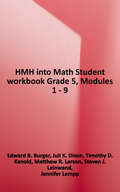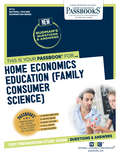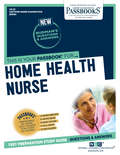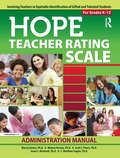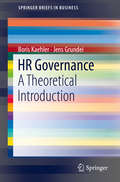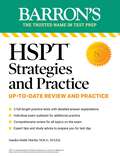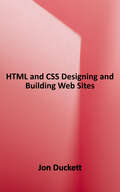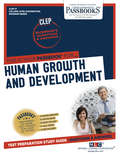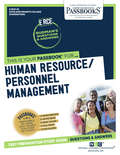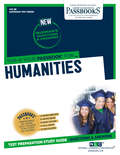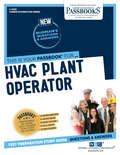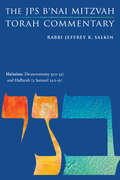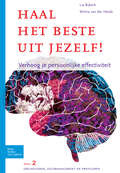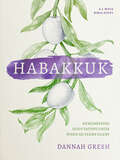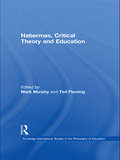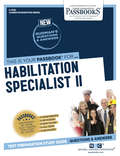- Table View
- List View
HIV/AIDS in Bangladesh: Stigmatized People, Policy and Place (Global Perspectives on Health Geography)
by Alak PaulThis book aims to show the conditions and behaviors of vulnerable and marginalized people in Bangladesh which put them at risk of HIV/AIDS infection, and what their adopted coping strategies are and how these play out. In addition, the book seeks to gain an understanding of the perceptions of civil society and policy planners with respect to vulnerability to HIV, and the necessary mitigation measures. While there is much published literature on the epidemiology and etiology for the most at-risk groups in the region, there has not yet been any in-depth research concerning the socio-cultural and geographic impacts of HIV issues in Bangladesh. Almost all of the literature shows HIV as an epidemiological problem rather than investigating it from a social or cultural point of view, and still less using qualitative methods. The present work is an endeavor to fill these gaps by providing valuable qualitative field data to demonstrate the causes of HIV risk and vulnerability, and to examine the nature of the social and locational context of HIV/AIDS in Bangladesh and to assist with health care policy planning. The book will be of use to students and researchers, studying public health, health geography, medical sociology, medical anthropology, social psychology and social epidemiology, and to professionals in the fields of development, community medicine, health management and social policy.
HMH: into Math Student workbook Grade 5, Modules 1 - 9
by Timothy D. Kanold Edward B. Burger Juli K. Dixon Steven J. Leinwand Matthew R. Larson Jennifer LemppWelcome to Into Math, Grade 5! In this program, you will develop skills and make sense of mathematics by solving real-world problems, using hands-on tools and strategies, and collaborating with your classmates. With the support of your teacher and by engaging in meaningful practice, you will learn to persevere when solving problems. Into Math will not only help you deepen your understanding of mathematics but also build your confidence as a learner of mathematics. Even more exciting, you will write all your ideas and solutions in your book. In your Into Math book, writing and drawing on the pages will help you think deeply about what you are learning, help you truly understand math, and most importantly, you will become a confident user of mathematics!
HOME ECONOMICS EDUCATION: Passbooks Study Guide (National Teacher Examination Series (NTE) #Nt-12)
by National Learning CorporationThe National Teacher/PRAXIS Examinations are designed to provide objective measurement of the knowledge, skills and abilities required of teachers. The Passbook® for the Home Economics Education exam provides hundreds of multiple-choice questions in the areas that will likely be covered on your upcoming certification test.
HOME HEALTH NURSE: Passbooks Study Guide (Certified Nurse Examination Series)
by National Learning CorporationThe Certified Nurse Examination Series prepares individuals for licensing and certification conducted by the American Nurses Credentialing Center (ANCC), the National Certification Corporation (NCC), the National League for Nursing (NLN), and other organizations. The Home Health Nurse Passbook® provides a series of informational texts as well as hundreds of questions and answers in the areas that will likely be covered on your upcoming exam.
HOPE Teacher Rating Scale: Involving Teachers in Equitable Identification of Gifted and Talented Students in K-12: Manual
by Scott J. Peters Marcia Gentry Nielsen Pereira Jason S. McIntosh C. Matthew FugateThe HOPE Teacher Rating Scale is designed to help guide teachers in identifying gifted students for programming. It is unique in several ways. First, it is short, with only 11 items that measure academic and social/affective components of giftedness, making it easy to use. Second, it is invariant when used to identify students from low-income and culturally diverse families. Third, it can be used across grade levels, K-12. Finally, local norms ensure that the data are relevant to the specific school populations. With multiple measures and multiple pathways crucial for reversing the inequities in identifying culturally, economically, and linguistically diverse students, a teacher-nomination instrument like the HOPE Teacher Rating Scale is an important component of identification systems. The HOPE Teacher Rating Scale items have been well-developed and subjected to research using more than 12,000 diverse students in five validity studies to date. This manual is useful in understanding and interpreting the electronic scores generated from teachers' ratings of their students. This instrument is a must-have for any administrator or gifted-program coordinator involved in student identification.To explore the full collection of HOPE print and online resources, please visit: https://www.routledge.com/go/hope-teacher-rating-scales.
HR Analytics and Digital HR Practices: Digitalization post COVID-19
by Subhankar Das Subhra R Mondal Francesca Di VirgilioThis book discusses the effect of global pandemic, Covid-19, on human resource and draws strategies with new job designing tools and techniques. It provides insights on how to develop new strategies for HR professionals in corporates and academicians. This book explores the implication of descriptive, predictive and prescriptive HR analytics practices for different functional domains and in different countries during COVID-19. It brings new dimensions of study in HR analytics which are sure to change after COVID-19 as it has affected the way people are going to work.
HR Governance: A Theoretical Introduction (SpringerBriefs in Business)
by Boris Kaehler Jens GrundeiHuman resource (HR) governance is a relatively new construct that has recently begun attracting more and more attention in both research and practice. As a part of corporate governance, it represents the internal and external normative framework of human resource management and its supervision in organizations. This book theoretically integrates HR governance with the related domains of corporate governance, general management, HR management, and leadership. By doing so, it provides scholars and practitioners in the field with a precisely delineated system of theoretical concepts for their work and helps to translate these concepts into concrete research questions and practical guidelines. By interpreting the new ISO 30408 norm on human governance and taking into account recent developments, the book helps to comply with and anticipate current and future HR regulations.
HSPT Strategies and Practice, Second Edition: Prep Book with 3 Practice Tests + Comprehensive Review + Practice + Strategies (Barron's Test Prep)
by Sandra Martin Barron's Educational SeriesBe prepared for exam day with Barron&’s. Trusted content from HSPT experts!Barron&’s HSPT Strategies and Practice, Second Edition includes in-depth content review and practice. It&’s the only book you&’ll need to be prepared for the High School Placement Test.Written by Experienced EducatorsLearn from Barron&’s--all content is written and reviewed by HSPT expertsBuild your understanding with comprehensive review tailored to the most recent examGet a leg up with tips, strategies, and study advice for exam day--it&’s like having a trusted tutor by your sideBe Confident on Exam DaySharpen your test-taking skills with 3 full-length practice tests--each of which features all five subtests that make up the HSPT (Verbal Skills, Quantitative Skills, Reading, Mathematics, and Language)Deepen your understanding by reviewing each test&’s detailed answer explanations with expert advice and use the scoring rubrics to check your learning progressStrengthen your knowledge with in-depth review covering all topics on the HSPT exam along with key strategies for success on each subtestReinforce your learning with hundreds of practice questions covering all tested topics, accompanied by detailed answers and explanationsGain confidence with individual exam subtests in each chapter, clear examples and solutions, a Vocabulary chapter that helps enhance Verbal and Reading skills, and much more
HTML & CSS Design and Build Websites
by Jon DuckettA two-book set for web designers and front-end developers This two-book set combines the titles HTML & CSS: Designing and Building Web Sites and JavaScript & jQuery: Interactive Front-End Development. Together these two books form an ideal platform for anyone who wants to master HTML and CSS before stepping up to JavaScript and jQuery. HTML & CSS covers structure, text, links, images, tables, forms, useful options, adding style with CSS, fonts, colors, thinking in boxes, styling lists and tables, layouts, grids, and even SEO, Google analytics, FTP, and HTML5. JavaScript & jQuery offers an excellent combined introduction to these two technologies using a clear and simple visual approach using diagrams, infographics, and photographs. - A handy two-book set that uniquely combines related technologies - Highly visual format and accessible language makes these books highly effective learning tools - Perfect for beginning web designers and front-end developers
HUM 101-1 Manvyavidyancha Adhishthan Abhyaskram F.Y.B.A - Y.C.M.O.U
by Prof. Dr. Siddheshwar Tagawale Prof. Gogate Prof. Dubale Shyamala Vanarase Shree. BahadurHUM 101-1 Manvyavidyancha Adhishthan Abhyaskram text book for F.Y.B.A from Yashwantrao Chavan Maharashtra Open University, Nashik in Marathi.
HUM 101-2 Manvyavidyancha Adhishtan Abhyaskram F.Y.B.A. - Y.C.M.O.U
by Prof. Dr. Eknath PagarHUM 101-2 Manvyavidyancha Adhishtan Abhyaskram Karyapustika text book for F.Y.B.A from Yashwantrao Chavan Maharashtra Open University, Nashik in Marathi.
HUMAN GROWTH AND DEVELOPMENT: Passbooks Study Guide (College Level Examination Program Series (CLEP))
by National Learning CorporationThe College Level Examination Program (CLEP) enables students to demonstrate college-level achievement and earn college credit in various subject areas based on knowledge acquired through self-study, high school and adult courses, or through professional means. The CLEP Human Growth and Development Passbook® prepares you by sharpening knowledge of the skills and concepts necessary to succeed on the upcoming exam and the college courses that follow. It provides a series of informational texts as well as hundreds of questions and answers in the areas that will likely be covered on your upcoming exam, including but not limited to: behavioral and cognitive development; biological development; family and society; personality and emotions; and more.
HUMAN RESOURCE/PERSONNEL MANAGEMENT: Passbooks Study Guide (Excelsior/Regents College Examination Series #Dantes-48)
by National Learning CorporationThe Excelsior/Regents College Examinations (E/RCE) offer you an opportunity to obtain recognition for college-level learning and consists of exams designed to demonstrate achievement and mastery of various college-level subjects, such as the Arts and Sciences, Business, Criminal Justice, Education, Health and Nursing. The E/RCE Human Resource/Personnel Management Passbook® prepares you by sharpening knowledge of the skills and concepts necessary to succeed on the upcoming exam and the college courses that follow. It provides a series of informational texts as well as hundreds of questions and answers in the areas that will likely be covered on your upcoming exam.
HUMANITIES: Passbooks Study Guide (Admission Test Series)
by National Learning CorporationThe Admission Test Series prepares students for entrance examinations into college, graduate and professional school as well as candidates for professional certification and licensure. The CLEP Humanities Passbook® prepares you by sharpening the skills and abilities necessary to succeed on your upcoming entrance exam. It provides hundreds of questions and answers in the areas that will likely be covered on your upcoming exam.
HUSITA7-The 7th International Conference of Human Services Information Technology Applications: Digital Inclusion—Building A Digital Inclusive Society
by C. K. Law Yu Cheung Wong John Yat Chu FungIn today’s information society, to make a real and lasting impact on human welfare takes applications of information technology aimed at enhancing access to all. HUSITA7-The 7th International Conference of Human Services Information Technology Applications: Digital Inclusion-Building a Digital Inclusive Society presents diverse viewpoints from around the globe, examining the latest applications of digital technology for social work education and practice. These conference presentations from respected international authorities discuss the application of ICT (information and communication technology) in various facets of human service to achieve the goal of a digital inclusive society where all have access to education and informational resources. HUSITA7-The 7th International Conference of Human Services Information Technology Applications examines the development and use of information technology in professional training, including the strengths and limitations of e-learning in social work curriculums along with the rationale behind a learning object approach. Research includes findings from educators in Canada describing the development and implementation of e-learning in social work programs and the qualitative study of technological content in an MSW curriculum. Various types of Web-based learning approaches are explored with an eye toward providing more effective teaching strategies. Various technological advances and approaches toward individual empowerment are described to facilitate greater societal inclusiveness. The book is well referenced and includes several helpful tables and figures. Topics in HUSITA7-The 7th International Conference of Human Services Information Technology Applications include: the learning object approach of e-learning for social work education challenges implementing e-learning in social work education a research study of the relationship between technology content in social work education and technology use in social work practice international partnerships in Web-based teaching effective integration of emotion into the content of Web-based learning the use of indigenous knowledge in content the use of Web CT for effective address of issues such as quality of teaching and communication bringing about social inclusion through effective digital government how technological advances impact assistive technology research on the Internet self-efficacy in older person’s learning of ICT a communication tool for the speech impaired improving social work service effectiveness through knowledge management (KM) the “SenSui” disability information resource in Japan HUSITA7-The 7th International Conference of Human Services Information Technology Applications is enlightening reading for librarians, social educators, social work students, researchers interested in ICT, and human service professionals.
HVAC Plant Operator: Passbooks Study Guide (Career Examination Series)
by National Learning CorporationThe HVAC Plant Operator Passbook® prepares you for your test by allowing you to take practice exams in the subjects you need to study. It provides hundreds of questions and answers in the areas that will likely be covered on your upcoming exam, including but not limited to: operation, maintenance and repair of pumps, motors, valves, mechanical and electrical equipment; plans and specifications; air conditioning and refrigeration; heating and ventilation; plumbing; and more.
Ha'azinu: The JPS B'nai Mitzvah Torah Commentary (JPS Study Bible)
by Rabbi Jeffrey K. SalkinThe JPS B’nai Mitzvah Torah Commentary shows teens in their own language how Torah addresses the issues in their world. The conversational tone is inviting and dignified, concise and substantial, direct and informative. Each pamphlet includes a general introduction, two model divrei Torah on the weekly Torah portion, and one model davar Torah on the weekly Haftarah portion. Jewish learning—for young people and adults—will never be the same. The complete set of weekly portions is available in Rabbi Jeffrey K. Salkin’s book The JPS B’nai Mitzvah Torah Commentary (JPS, 2017).
Haadina mulaka Aata - Paata
by National Book trust IndiaA poem for childrens which gives moral and knowledge for the childrens
Haal het beste uit jezelf!: Verhoog je persoonlijke effectiviteit
by Lia Bijkerk Wilma van der HeideHoe kunnen studenten maximaal gebruik maken van hun kwaliteiten en interesses tijdens hun opleiding, in stages, bij het afstuderen en tijdens het werk? Hoe kunnen studenten beter omgaan met stress en met de tijd? Hoe kunnen zij betere gesprekken leren voeren en effectiever samenwerken? Hoe onderscheiden zij zich van de anderen en kunnen zij innovatieve producten en diensten verzinnen? Allemaal vragen die studenten graag beantwoord zien tijdens hun opleiding om gerichte keuzes te kunnen maken en om zo efficiënt en effectief mogelijk te studeren.In dit tweede deel van het boek voor studenten wordt de theorie van nog acht thema’s in het kader van persoonlijke effectiviteit beknopt beschreven. De hoofdstukken zijn overzichtelijk ingedeeld met daarin een praktijkvoorbeeld afkomstig uit het hbo, de beschrijving van de algemene competentie waaraan gewerkt wordt en een leertekst met voorbeelden, tips, modellen, vuistregels, do’s en dont’s. De hoofdstukken eindigen met praktische opdrachten en een doorverwijzing naar specifieke literatuur of websites die ondersteunend kunnen werken.Op de, bij het boek behorende website, kunnen studenten de testen uit het boek maken en de benodigde bestanden voor hun portfolio downloaden. Met behulp van dit boek kunen studenten de algemene competenties: organiseren, zelfmanagement en profileren vergroten. Het boek kan gebruikt worden als hulpmiddel bij lessen in het kader van de studieloopbaanbegeleiding of als ondersteuning bij regiekring bijeenkomsten. Studenten kunnen het boek ook individueel doorwerken om het beste uit zichzelf te halen.
Habakkuk and Zephaniah: Wrath and Mercy (International Theological Commentary (ITC))
by Maria Eszenyei SzelesNeither Habakkuk nor Zephaniah is very well known or understood by our generation. These Old Testament prophets, who were contemporary with Jeremiah, interpreted events leading up to the total destruction of Jerusalem by Nebuchadnezzar, the Babylonian "king of kings and lord of lords," in 597 and 587 B.C. Writing from within a Socialist society, Mária Eszenyei Széles offers a unique perspective on Habakkuk and Zephaniah — a profoundly moving interpretation of the mystery of God's apparent absence or weakness when his own people meet with intolerable suffering at the hands of a cruel totalitarian regime.
Habakkuk: Remembering God's Faithfulness When He Seems Silent
by Dannah GreshWhy does God seem silent when I need Him most?The prophet Habakkuk faced great storms in life. His fears of the future crippled him with doubt and left him questioning God. How is it, then, that he is now a shining example of how the righteous live by faith?Learn how the storms of life can become opportunities to activate your faith in Habakkuk: Remembering the Faithfulness of God When He Seems Silent. You&’ll study the book of Habakkuk—which maybe you&’ve never done before!—and discover how remembering is essential to understanding the faithfulness of God. Through daily Scripture, prayer, and meditation, you&’ll enter the life of this prophet, and:Gain freedom to express your fear and frustration to GodRemember that God is at work—even when He seems silentIncrease your capacity to practice the art of waiting on GodLearn how to navigate through the storms of life to live free from fear and full of joyThis six-week study provides daily interactive Bible study and an easy-to-use leader&’s guide for group participation. Dannah Gresh also hosts a six-session podcast series to kick off each week of study. Find it at dannahgresh.com.
Habakkuk: Remembering God's Faithfulness When He Seems Silent
by Dannah GreshWhy does God seem silent when I need Him most?The prophet Habakkuk faced great storms in life. His fears of the future crippled him with doubt and left him questioning God. How is it, then, that he is now a shining example of how the righteous live by faith?Learn how the storms of life can become opportunities to activate your faith in Habakkuk: Remembering the Faithfulness of God When He Seems Silent. You&’ll study the book of Habakkuk—which maybe you&’ve never done before!—and discover how remembering is essential to understanding the faithfulness of God. Through daily Scripture, prayer, and meditation, you&’ll enter the life of this prophet, and:Gain freedom to express your fear and frustration to GodRemember that God is at work—even when He seems silentIncrease your capacity to practice the art of waiting on GodLearn how to navigate through the storms of life to live free from fear and full of joyThis six-week study provides daily interactive Bible study and an easy-to-use leader&’s guide for group participation. Dannah Gresh also hosts a six-session podcast series to kick off each week of study. Find it at dannahgresh.com.
Habermas, Critical Theory and Education (Routledge International Studies in the Philosophy of Education)
by Mark Murphy Ted FlemingThe sociologist and philosopher Jürgen Habermas has had a wide-ranging and significant impact on understandings of social change and social conflict. However, there has been no concerted and focused attempt to introduce his ideas to the field of education broadly. This book rectifies this omission and delivers a definitive contribution to the understanding of Habermas's oeuvre as it applies to the field. The authors examine the contribution Habermas's theory has and can make to: pedagogy, learning and classroom interaction; the relation between education, civil society and the state; forms of democracy, reason and critical thinking; and performativity, audit cultures and accountability. Additionally, the book answers a range of more specific questions, including: what are the implications for pedagogy of a shift from a philosophy of consciousness to a philosophy of language?; What contribution can Habermas's re-shaping of speech act theory and communicative rationality make to theories of classroom interaction?; and how can his theories of reason and colonization be used to explore questions of governance and accountability in education?
Habilidades De Conversación: Construir Relaciones Exitosas Sin Esfuerzo
by Jacob Andrews Paola Cuenca¿Teme iniciar una conversación? ¿Alguna vez quiso hablar con alguien pero no supo qué decir? ¿Se sintió incomodo al conocer a alguien por primera vez? ¿Piensa que la conversación casual es una pérdida de tiempo?Si la respuesta a estas preguntas es sí, ¡Éste libro es para usted!Esto es lo que aprenderá al leer Habilidades de Conversación:-Convertirse en un conversador efectivo-Causar una buena primera impresión-Crear comunicación mediante habilidades de conversación casual-La importancia de la comunicación no verbal y como sacar ventaja de la misma-Tratar con la ansiedad social-Tácticas para superar el temor a hablar con individuos y grupos-Crear una conexión con la otra persona-Utilizar rompehielos para iniciar una conversación-Mantener viva la conversación y hacer ha hablar al otro-Cómo poner fin a una conversación-Conversar con confianza-Nunca mas quedarse sin palabrasEl ser bueno para la conversación es una habilidad poderosa. Resultará ser invaluable cuando se encuentre en una entrevista laboral, una fiesta, o quiera abordar a alguien que cree que podría ser un futuro compañero romántico.
Habilitation Specialist II: Passbooks Study Guide (Career Examination Series)
by National Learning CorporationThe Habilitation Specialist II Passbook® prepares you for your test by allowing you to take practice exams in the subjects you need to study. It provides hundreds of questions and answers in the areas that will likely be covered on your upcoming exam, including but not limited to: coding information; developing and implementing habilitation plans; supervision; understanding and interpreting written material; and more.

